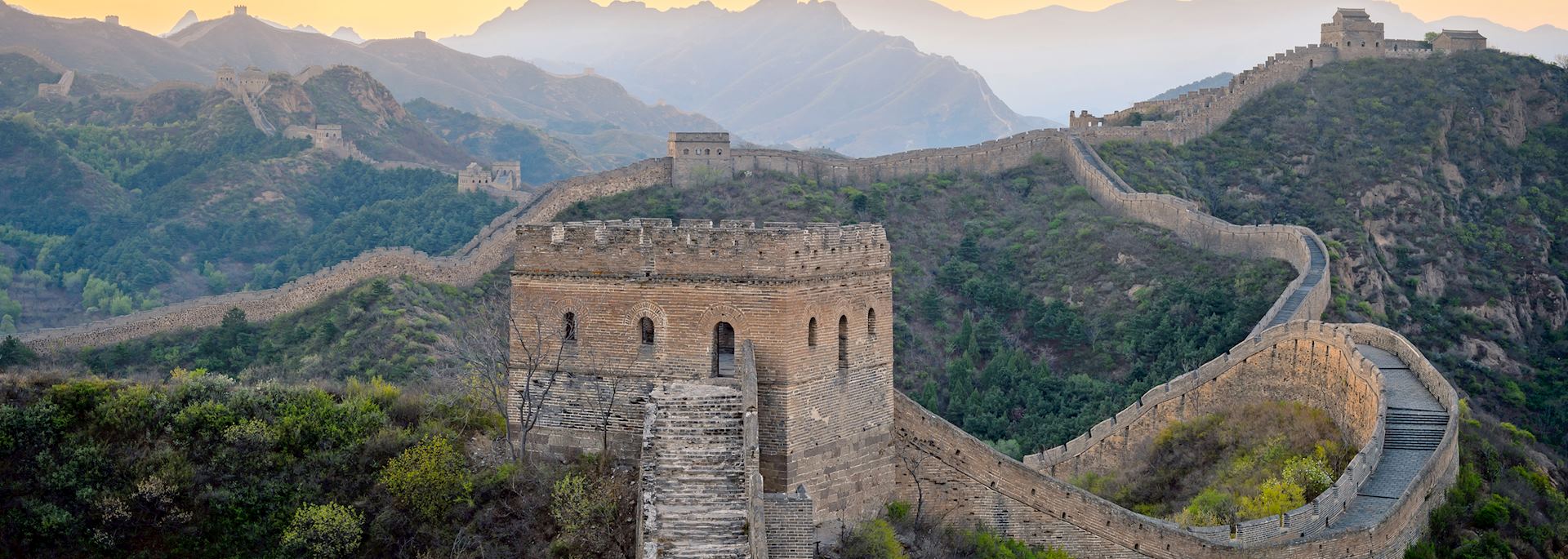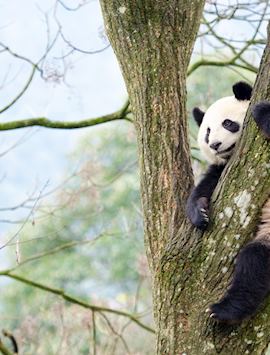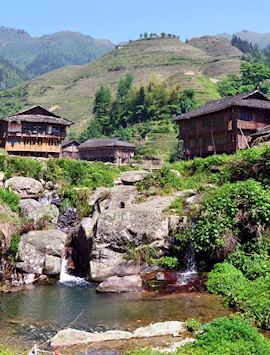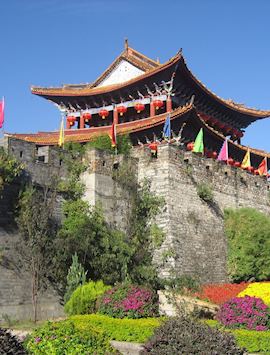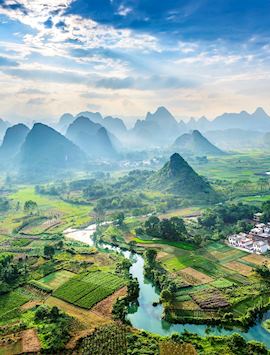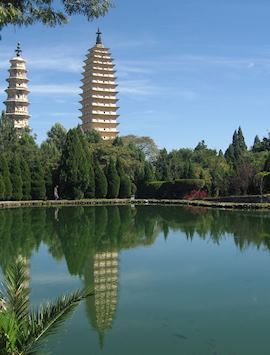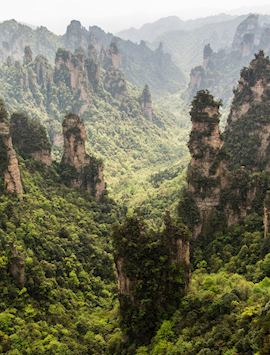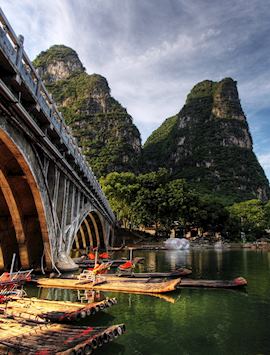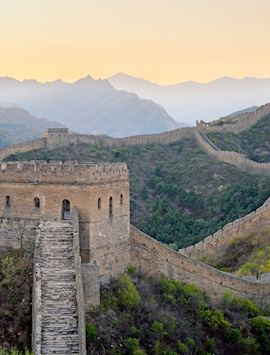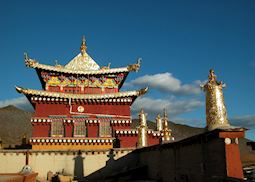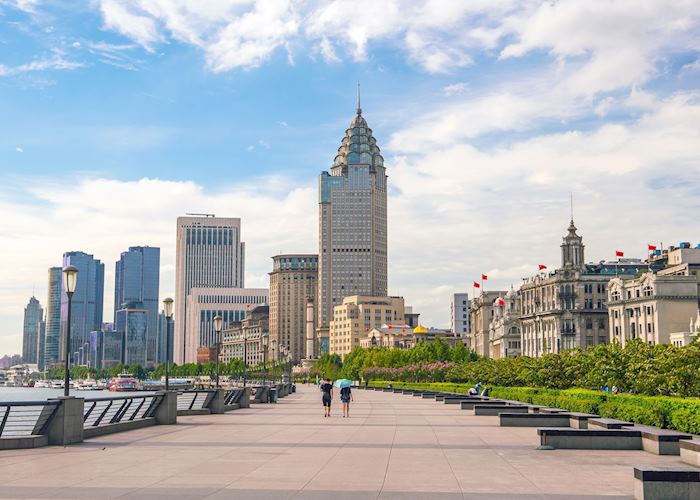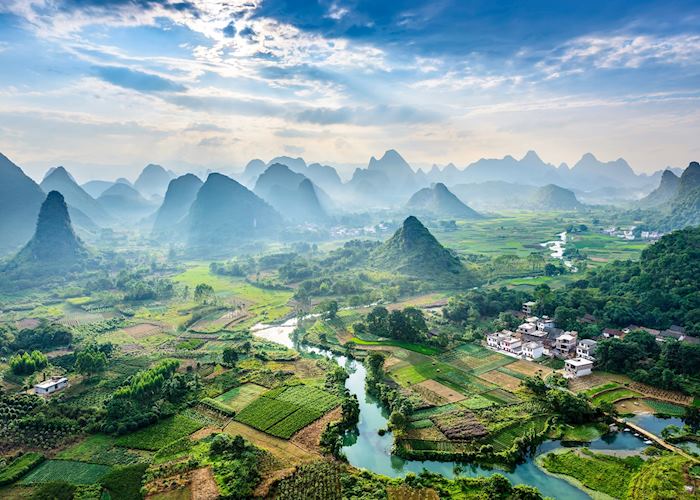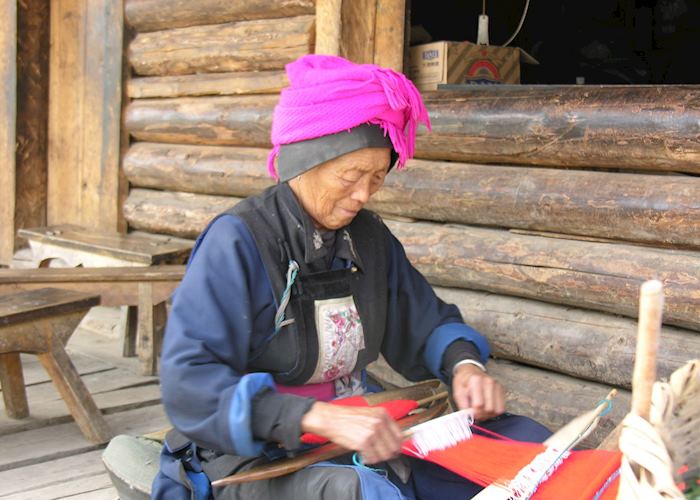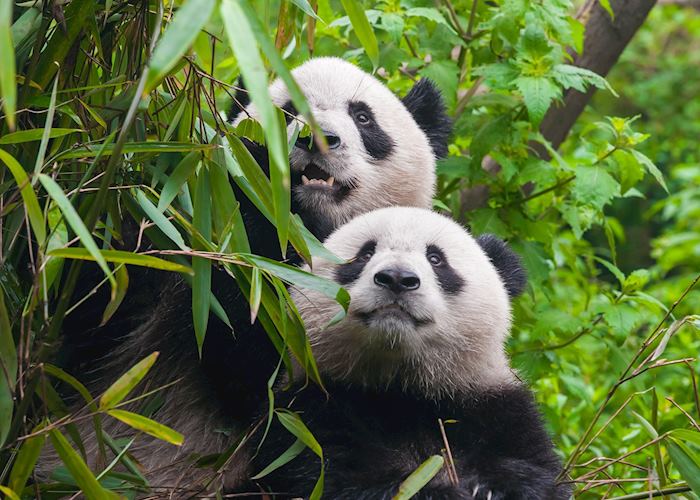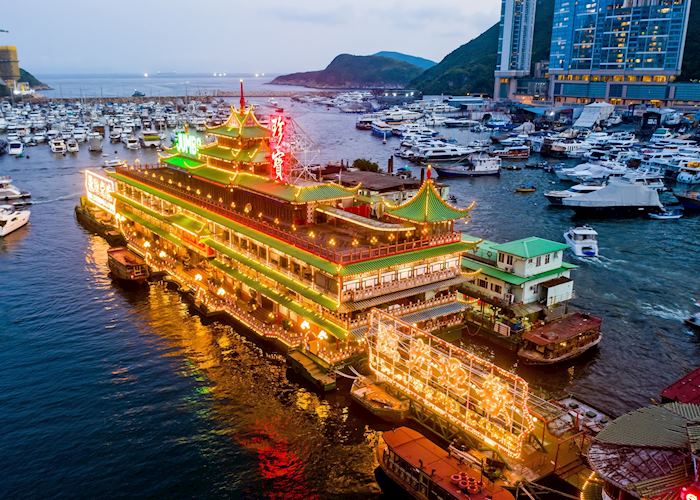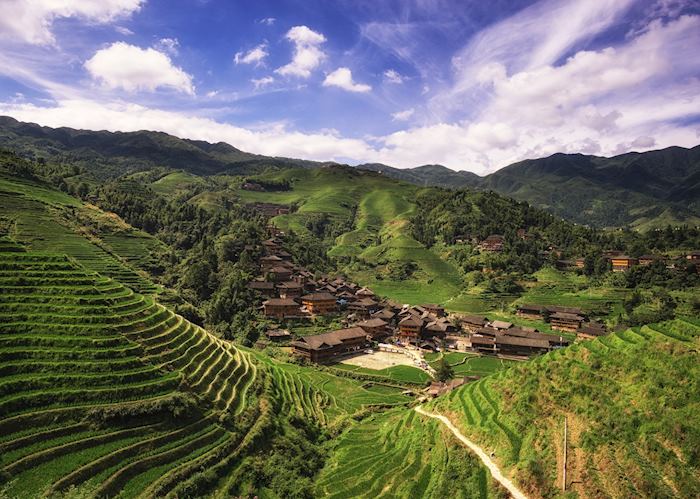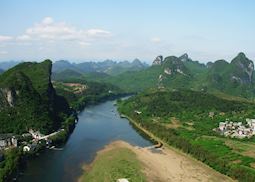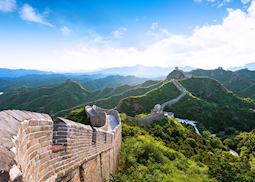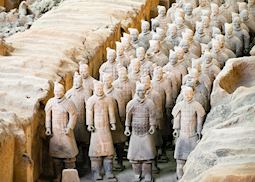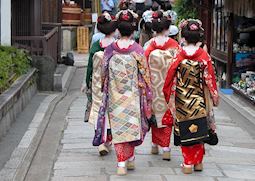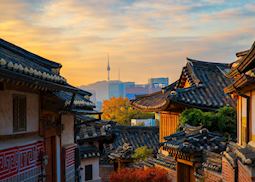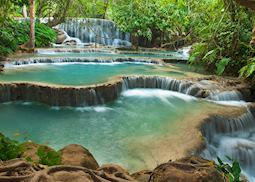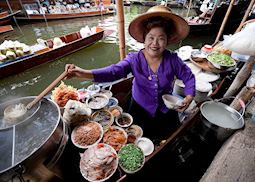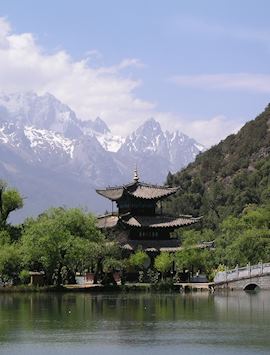
The Great Wall snaking over the horizon, impassive rows of Terracotta Warriors, sacred mountains, giant pandas munching bamboo… On a tailor-made holiday to China with Audley, you’ll see the highlights — and much more — your way. We’ll design your ideal trip with you, paying close attention to your interests, your travel style and your budget. Our China specialists know the country inside out and can lead you to experiences you won’t find in a guidebook.
Weave through frenetic city markets selling everything from jade trinkets to deep-fried locusts. Drink in Shanghai’s skyline from a rooftop bar. Hike through swirling, emerald-green rice terraces in the peaceful backcountry of Longji. Eat your way around Beijing on a guided breakfast tour, or dine at a family home in Xian.
Buddhist monasteries and giant prayer wheels. Cooking classes in Beijing’s backstreets. Ming-dynasty walled towns. The towering limestone peaks of Guilin. What excites you? Travel at your own pace, in your own style, with the confidence that we’ll show you the best options, wherever you go.
Suggested tours for China
These tours give you a starting point for what your holiday to China could entail. Treat them as inspiration, as each trip is created uniquely for you.
Suggested activities for China
Whatever your interests, our specialists will build activities into your trip that connect to how you want to experience China.
-
The Dragon's Backbone walk ![Walk Along the Dragon's Backbone]()
The Dragon's Backbone walk
LongjiThe Dragon's Backbone walk
For those who enjoy a little more exercise, the Dragon's Backbone Rice Terraces at Longji offer a fantastic opportunity to get out into the countryside and visit some wonderful, traditional villages.
View details -
Songzanlin Monastery ![Songzanlin Monastery]()
Songzanlin Monastery
Shangri-LaSongzanlin Monastery
This 300-year-old monastery houses over 600 Tibetan monks and is one of the most prominent Tibetan monasteries in southwest China.
View details -
Giant Panda Breeding Research Base visit ![Giant panda, Chengdu]()
Giant Panda Breeding Research Base visit
ChengduGiant Panda Breeding Research Base visit
The Giant Panda Breeding Research Base, situated in the north of Chengdu, provides an excellent opportunity to get as close as possible to China's "ambassador" animal.
View details
Why travel with Audley?
- 100% tailor-made tours
- Fully protected travel
- Established for over 25 years
- 98% of our clients would recommend us
Best time to visit
Our specialists advise on the best months to visit China, including information about climate, events and festivals.
Request our brochure
Covering all seven continents, The World Your Way shows you how you can see the world with us. It features trip ideas from our specialists alongside hand-picked stays and experiences, and introduces our approach to creating meaningful travel experiences.

Useful information for planning your holiday in China
The official language of China is Mandarin Chinese. Among the enormous number of local dialects, large groups speak Cantonese, Fukienese, and Minnanhua. Inner Mongolia, Tibet, and Xinjiang, which are autonomous regions, have their own languages. In the countryside, strong regional accents, and local dialects (there can be many differences even within a single province) mean that even native Mandarin speakers can struggle to communicate at times.
The currency of China is the renminbi (RMB), more commonly known as the yuan. ATMs can be found in Chinese cities, though only Visa or Mastercard will be accepted in most of them.
While the use of cash is decreasing in China as payment apps like Alipay become more popular, it’s still possible to pay in cash or by card in many places. Your specialist and in-country guide can advise on what will be most suitable for your trip.
Chinese food is known all over the world and while visiting, you should try signature dishes from each region you visit. Ingredients and cooking styles vary across the country creating a complex symphony of dishes that can make eating out in China a highlight of a visit.
There are four major regional cooking styles with northern cuisine featuring dishes such as Peking duck, Mongolian hotpot, and shuijiao (boiled dumplings). Food in the east is rich, sweet, and often pickled, western cuisine such as Sichuan and Hunan food, is spicy, and often sour and peppery, while southern (Cantonese food) is most familiar to Westerners.
One of the best-known national drinks is baijiu, a fiery distilled rice wine. The local beer, Qingdao, is similar to German lager and there are also some good wines.
In general tipping is not expected in China, however, porters, waiters, and room attendants in international hotels will appreciate a small sum. It’s more common to tip guides and drivers and your specialist can advise on appropriate amounts closer to your travel dates.
For the latest travel advice for China, including entry requirements, health information, and the safety and security situation, please refer to the Foreign, Commonwealth & Development Office website.
In China, you can stay in boutique hotels, historic mansions, simple guesthouses, or international chain hotels. The choice of places to stay in China’s cities is generally varied and includes luxurious urban retreats as well as sleek, modern hotels, while in more rural areas hotels generally have more local character.
For example, you could stay in a beautifully restored Tang Dynasty house in Hangzhou, a private villa in a lush garden in Lijiang, a small boutique hotel in Xiamen, or a simple courtyard house in Dali. Wherever you decide to go, your specialist will help you find the right place for each night’s stay, but for some ideas you can browse our collection of places to stay in China.
To see China’s cultural and scenic highlights including the Great Wall, Forbidden City, and Terracotta Army, you should go to Beijing, Xian, and Shanghai. Imperial treasures, historic city streets, and the expansive Olympic Park await in Beijing. Xian is home to a legion of life-size warriors carved to protect an emperor in the afterlife, and Shanghai’s juxtaposition of ancient and modern sees tradition and excess run side by side.
China is a vast country and you may also want to see pandas in Chengdu or the towering karst pinnacles and traditional villages around Guilin, take a hike along the Tiger Leaping Gorge, or follow ancient traders along the Silk Route. Your specialist will help you narrow down the options and plan a trip that covers all your interests.
Imperial cities, sacred mountains, temples, shrine, and markets — China offers a bounty of places to discover and things to do. Its finely tuned balance between age-old tradition and pioneering innovation combined with its rich customs and heritage make it a fascinating country to explore.
You can walk China’s Great Wall or marvel at the impassive Terracotta Warriors, visit incense-filled temples, or wander buzzing markets. You could discover the roots of China’s culinary prowess on a Shanghai food tour, walk the Dragon’s Backbone to the see the Longji rice terraces, or discover local life on a guided countryside bike ride.
Maybe you’d like to explore Beijing’s hutongs (backstreets), watch the sun set over Shanghai from a rooftop bar, or visit Ming-dynasty walled towns, or the historic markets of Hong Kong. China encompasses it all, and so much more.
It takes between ten and 12 and a half hours to fly from the UK to Shanghai in China.
The time zone in China is UTC+8 hours across the whole country. Daylight Savings Time isn’t observed.
The best way to get around in China is by rail or air. High-speed trains link all the main cities and are fast, efficient, and comfortable. For longer journeys, we can book internal flights, while for more local travel, a private driver-guide gives you the freedom to enjoy the sights and stay informed as you travel.
Improved infrastructure and increased political freedoms mean it’s also possible to combine a visit to China with overland travel into northern Vietnam. Speak to your specialist for more information.
Use our travel tool to find up-to-date visa and passport requirements for China. Enter where you’re travelling to and from (including any stopover destinations en route or flight layovers), along with your intended travel dates and passport details, for a full list of requirements.
Your doctor can provide you with vaccine advice for China, but you should also ensure you’re up to date with the recommended vaccinations for your home country. You can also check the suggested vaccinations on the Travel Health Pro website.
China in pictures
Our expert guides to travelling in China
Written by our specialists from the viewpoint of their own travels, these guides will help you decide on the shape of your own trip to China. Aiming to inspire and inform, we share our recommendations for how to appreciate China at its best.
-
![Audley presents China]()
Audley presents China
China rewards the curious visitor with many hands-on, guided experiences. On your tailor-made trip, you could make dumplings in a cooking class, hike the Great Wall without the crowds, or cycle Shanghai’s quieter, locals-only districts.
-
What to do in China: our highlights guide ![Yangshuo, China]()
What to do in China: our highlights guide
What to do in China: our highlights guide
Visit China’s Forbidden City and Terracotta Warriors, walk the Great Wall, hike along the Dragon’s Backbone, and meet the native minorities in the Yunnan and Guizhou provinces. China specialist Alice picks her top things to see and do when visiting this vast country.
Read this guide -
The Great Wall of China: taking a quieter path ![Great Wall of China]()
The Great Wall of China: taking a quieter path
The Great Wall of China: taking a quieter path
Unmistakable in its appearance and scale, the Great Wall of China wends across the hills, mountains and valleys of northern China. For most visitors, blanking out time to visit this man-made wonder is a must — China specialist Susan outlines the best ways to do this.
Read this guide -
How to see pandas in China: everything you need to know ![Panda cub at Chengdu Panda Research Base]()
How to see pandas in China: everything you need to know
How to see pandas in China: everything you need to know
China specialist Rick explains why Chengdu Research Base of Giant Panda Breeding is our choice for seeing China’s ambassador animal in a responsible way, and how to make the most of your visit to Sichuan province.
Read this guide -
Our guide to exploring the Terracotta Army of Xian ![Terracotta Warriors, Xian]()
Our guide to exploring the Terracotta Army of Xian
Our guide to exploring the Terracotta Army of Xian
Make the most out of visiting China’s Terracotta Army: we explain what to look for when exploring this archaeological site that predates Christianity.
Read this guide
Other popular destinations
Still looking for ideas? If China has captured your interest, we think you might also like these destinations.

